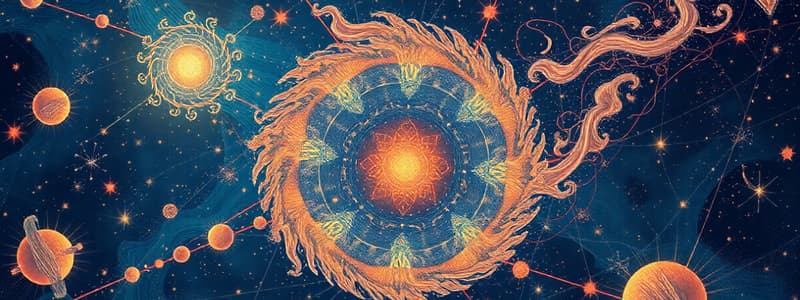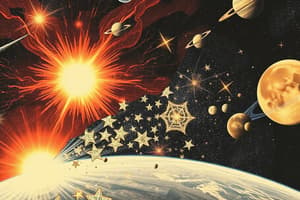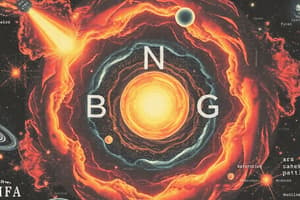Podcast
Questions and Answers
What primarily drives the conversion of hydrogen atoms to helium atoms in the early universe?
What primarily drives the conversion of hydrogen atoms to helium atoms in the early universe?
- Increase in atomic particle density
- Thermo nuclear fusion reactions (correct)
- Formation of neutron stars
- Loss of electron energy
What is the first step in the formation of hydrogen and helium atoms?
What is the first step in the formation of hydrogen and helium atoms?
- Initial atomic particles formation (correct)
- Thermo nuclear fusion
- Condensation of stars
- Emission of cosmic rays
During the formation of stars from gas clouds, which process initiates the star's energy production?
During the formation of stars from gas clouds, which process initiates the star's energy production?
- Massive gas cloud dissipation
- Increasing gravitational forces leading to fusion (correct)
- Absorption of cosmic rays
- Condensation of hydrogen and helium
Which of the following best describes the result of hydrogen atoms converting into helium atoms?
Which of the following best describes the result of hydrogen atoms converting into helium atoms?
What ultimately happens to the hydrogen and helium gases after they condense into stars?
What ultimately happens to the hydrogen and helium gases after they condense into stars?
What event marked the beginning of the formation of our planet according to the Big Bang theory?
What event marked the beginning of the formation of our planet according to the Big Bang theory?
Approximately how many years ago did the Big Bang occur, leading to the formation of our planet?
Approximately how many years ago did the Big Bang occur, leading to the formation of our planet?
Which of the following does the Big Bang theory NOT explain?
Which of the following does the Big Bang theory NOT explain?
Which of these concepts is most directly associated with the initial event described in the Big Bang theory?
Which of these concepts is most directly associated with the initial event described in the Big Bang theory?
What does the Big Bang theory imply about the universe's current state?
What does the Big Bang theory imply about the universe's current state?
Flashcards
Big Bang theory
Big Bang theory
Theory explaining the origin of our planet with a massive initial explosion that created matter and space.
Earth's origin
Earth's origin
The beginning of Earth's formation, estimated around 13.7 billion years ago.
13.7 billion years ago
13.7 billion years ago
The estimated time frame of the Big Bang and the beginning of Earth's formation.
Formation of the Universe
Formation of the Universe
Signup and view all the flashcards
Matter and Space creation
Matter and Space creation
Signup and view all the flashcards
Initial Atomic Particles
Initial Atomic Particles
Signup and view all the flashcards
Hydrogen & Helium Atom Formation
Hydrogen & Helium Atom Formation
Signup and view all the flashcards
Star Formation
Star Formation
Signup and view all the flashcards
Thermo Nuclear Fusion
Thermo Nuclear Fusion
Signup and view all the flashcards
Hydrogen to Helium Conversion
Hydrogen to Helium Conversion
Signup and view all the flashcards




